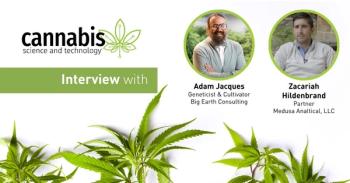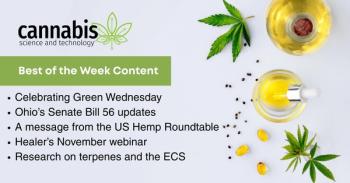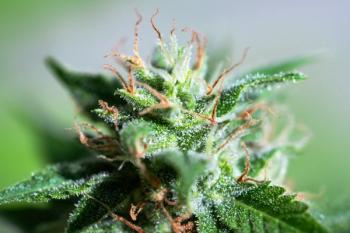
Cannabis Science and Technology
- May/June 2019
- Volume 2
- Issue 3
High-Resolution Tandem MS Applications in Cannabis Product Development
Better, accurate and more reliable analytical testing is needed in the industry. The author discusses one such method that goes well beyond the current contaminant testing done today in most laboratories.
Abstract / Synopsis:
As cannabis legalization gains momentum, an emerging industry has been created that has a need for accurate, reliable and innovative analytical testing. In my role as Director of Analytical Chemistry at Next Frontier Biosciences, I chose high-resolution liquid chromatography/mass spectrometry (LC/MS) to meet these needs. In this article, I will discuss applications in routine testing (potency and contaminants) as well as those more specialized (terpenes, lipids, etc.). Tandem quadrupole/time-of-flight (QTOF) mass spectrometry is shown to be a valuable tool in routine and custom applications that will contribute to the next generation of cannabis products. LC/MS capability in the cannabis laboratory goes well beyond contaminate testing currently used in most cannabis third-party testing labs.
Article:
Cannabis legalization has created a new industry for consumer products with recreational and medical applications. The diversity and complexity of products in development rely on thorough and accurate characterization to meet desired end points. Often developers use third-party laboratories to perform this characterization. Mass spectrometry is a key technology for contaminate testing but is often overlooked for other applications. In this article I will recount my time as Director of Analytical for a cannabis biotech company and the high resolution-mass spectrometry (HRMS) applications we developed and used for our research and product development.
Quantitative Cannabinoid Potency by LC/QTOF
In the cannabis industry, the most immediate need for characterization is potency of cannabinoids in flower and concentrates. HRMS was selected as our primary analytical technology, so I initially worked to develop a separation and quantification for cannabinoids.
It’s worth mentioning that HRMS does not provide inherent selectivity for cannabinoids with the same molecular formula. Our scientists evaluated this firsthand and found the differences in MS/MS were too subtle for routine use in quantitation. The necessity for a good LC separation was imperative. Our initial efforts focused on identifying a column stationary phase that had unique selectivity for cannabinoids. The screening process was evaluated by resolution of cannabinoids (CBD), delta-9-tetrahydrocannabinol (Δ9-THC) and delta-8-tetrahydrocannabinol (Δ8-THC) under isocratic conditions. Our laboratory screened more than 10 phases from several manufacturers. Once the phase providing the greatest resolution was identified, we worked on other parameters to obtain a separation of 12 cannabinoids. An example is shown in Figure 1 of the signals for m/z 315.232 and 359.222.
Not long after our separation was established, we found that, for accurate quantitation in the various matrices, there was a need for a relevant internal standard (ISTD). The evolution of ISTD in our laboratory started with deuterated cannabinoids, a paraben, and finally an isoflavone. Unfortunately, we found the purity of the deuterated standards available at the time less than adequate, and the paraben was prolific in the environment.
The quality of cannabinoid standards has improved greatly since that time, so these may be worth re-evaluating. However for our application, the isoflavone worked well. We performed basic validation (accuracy, linearity selectivity) in flower and concentrate and comparison studies with liquid chromatography/ultraviolet detection (LC/UV). The results of our equivalency study are shown in Figure 2.
Our accuracy for cannabinoids was routinely ±10% or better (as monitored by check standards and a control sample). While this may not rival the best LC/UV techniques, we had some inherent advantages with HRMS. The advantages of using HRMS observed were selectivity for cannabinoids versus matrix and the ability to run information-dependent MS/MS scans information dependent acquisition (IDA) in the background for identification of unknown components of interest or verification of compounds identified. The IDA data could be re-evaluated weeks or months after a sample was tested to look for non-target components of interest. Our laboratory analysed hundreds of flower and oil samples with a high degree of confidence in the results.
Semi-Quantitative Terpenes by LC/QTOF
After successful implementation of a quantitative cannabinoid HRMS analytical method, the next obvious need was characterization of terpenes. LC/MS is not typically thought of for analysis of volatile compounds but has some advantages over thermally intensive methods such as gas chromatography (GC). The initial work in my laboratory was to simply obtain terpenes response in the MS. This was accomplished through atmospheric pressure chemical ionization (APCI). Again, the common molecular formula pointed to the need for good chromatographic resolution.
Unfortunately, our laboratory equipped our LC/MS with a high-performance liquid chromatography (HPLC) instead of an ultra-performance liquid chromatography (UPLC). There were significant limitations in the resolution of terpenes with a standard HPLC method. As demonstrated for other complex separations, UPLC probably would be a better choice. However, for our research, the partial resolution and semi-quantitative information was sufficient to characterize the samples of interest. We could easily distinguish classes of terpenes (monoterpenes versus sesquiterpenes) and differentiate strains of cannabis. Figure 3 shows an example of terpene standard analysed by HRMS with identification of common terpenes.
Cannabis Lipidomics
Due to potential impact on finished product quality and customer appeal, lipid content of cannabis materials quickly drew the attention of our organization. Our raw material suppliers frequently described a myriad of processes to remove lipids. Lipids were of known concern to our formulators and little was known about what species were present or how effective the removal processes were. For this project, our lab utilized lipidomics (Sciex Lipidview) software and HRMS to create profiles of lipids in cannabis oils. The application was almost exactly that used in biological lipid characterization where an extract is infused into the MS and known parent lipid m/z and fragments are measured. Figure 4 shows the negative ion fatty acid lipid profile of hemp oil. Figure 5 shows the positive ion triacyl glyceride profile of hemp oil. Hemp oil was chosen for development as it would be easy to implement as a long-term control sample.
Our laboratory was successful in providing semi-quantitative values for lipid species and to characterize effectiveness of lipid removal processes. It was speculated this data could be useful in developing IP lipid removal processes and determining if the lipids themselves may have commercial value. Unfortunately, our laboratory wasn’t able to perform widespread characterization of cannabis materials using this technology, but we were able to demonstrate feasibility.
Conclusion
The complexity of the cannabis plant coupled with a diverse emerging commercial market provides significant opportunity for analytical scientists to utilize HRMS beyond contaminate testing. The applications I have described here only serve to highlight the utility of HRMS in this industry.
My hope is contract laboratories and cannabis product development companies can rethink initial capital expenditure in LC/MS to obtain improved return on these investments.
Kris Chupka is the former Director of Analytical Chemistry at Next Frontier Biosciences in Denver, Colorado. Direct correspondence to
How to Cite This Article:
Chupka K et al., Cannabis Science and Technology 2(3), 58-61 (2019)
How to Cite This Article:
Chupka K et al., Cannabis Science and Technology 2(3), 58-61 (2019)
Articles in this issue
over 6 years ago
How ERP Solutions Support Accountability in Cannabis Businessesover 6 years ago
Regulation Nationover 6 years ago
Beyond Potency: The Importance of Terpenesover 6 years ago
Understanding the Science of Cannabis Product Developmentover 6 years ago
Inter-Lab Variation in the Cannabis Industry, Part II: SolutionsNewsletter
Unlock the latest breakthroughs in cannabis science—subscribe now to get expert insights, research, and industry updates delivered to your inbox.



